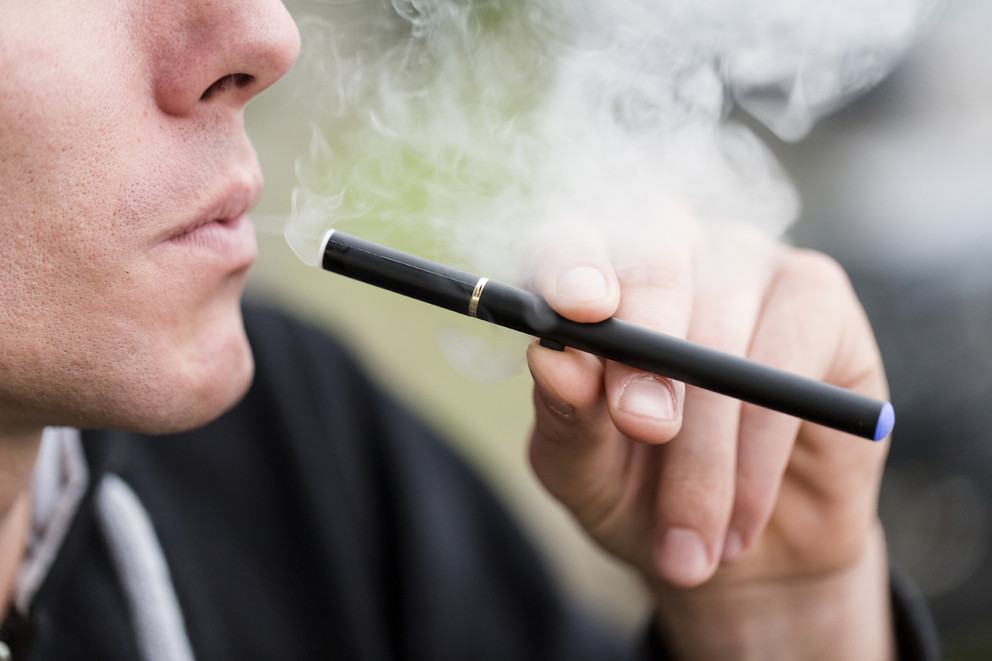HERSHEY — E-cigarettes appear to be less addictive than cigarettes for former smokers and this could help improve understanding of how various nicotine delivery devices lead to dependence, according to researchers.
“We found that e-cigarettes appear to be less addictive than tobacco cigarettes in a large sample of long-term users,” said Jonathan Foulds, professor of public health sciences and psychiatry, Penn State College of Medicine.
The popularity of e-cigarettes, which typically deliver nicotine, propylene glycol, glycerin and flavorings through inhaled vapor, has increased in the past five years. There are currently more than 400 brands of “e-cigs” available. E-cigs contain far fewer cancer-causing and other toxic substances than cigarettes, however their long-term effects on health and nicotine dependence are unknown.
To study e-cigarette dependence, the researchers developed an online survey, including questions designed to assess previous dependence on cigarettes and almost identical questions to assess current dependence on e-cigs. More than 3,500 current users of e-cigs who were ex-cigarette smokers completed the Penn State Cigarette Dependence Index and the Penn State Electronic Cigarette Dependence Index.
Higher nicotine concentration in e-cig liquid, as well as use of advanced second-generation e-cigs, which deliver nicotine more efficiently than earlier “cigalikes,” predicted dependence. Consumers who had used e-cigs longer also appeared to be more addicted.
“However, people with all the characteristics of a more dependent e-cig user still had a lower e-cig dependence score than their cigarette dependence score,” Foulds said. “We think this is because they’re getting less nicotine from the e-cigs than they were getting from cigarettes.”
Although many regular users on e-cigarettes are trying to quit smoking, the Food and Drug Administration has not approved them for this use, and they cannot be marketed as a smoking cessation product.
“This is a new class of products that’s not yet regulated,” Foulds said. “It has the potential to do good and help a lot of people quit, but it also has the potential to do harm. Continuing to smoke and use e-cigarettes may not reduce health risks. Kids who have never smoked might begin nicotine addiction with e-cigs. There’s a need for a better understanding of these products.
“We don’t have long-term health data of e-cig use yet, but any common sense analysis says that e-cigs are much less toxic. And our paper shows that they appear to be much less addictive, as well. So in both measures they seem to have advantages when you’re concerned about health.”
The findings, which are published in Nicotine & Tobacco Research, also have implications for developing e-cigs for smoking cessation.
“We might actually need e-cigarettes that are better at delivering nicotine because that’s what’s more likely to help people quit,” Foulds said.
Previous research shows that nicotine replacement efficacy correlates with higher nicotine dose and faster delivery speed.
The new index used in the study is more modern than the most widely used dependence survey, the Fagerstrom Test for Nicotine Dependence. That scale was developed 25 years ago and does not reflect modern use of tobacco and nicotine products.
“People smoke fewer cigarettes today but are still clearly addicted, and the old scale — while still reasonably effective — was not designed to measure that,” Foulds said.
The new questionnaire also allows for cross-comparisons between different nicotine and tobacco products.
“Not only are e-cigs a booming industry, but new tobacco products are set to enter the market soon,” Foulds said. “Our questionnaire is designed to compare dependence across different products simply by substituting the different product name into the questionnaire in place of cigarettes.”
Additional researchers on this project are Susan Veldheer, research coordinator, Jessica Yingst, research assistant, and Shari Hrabovsky, research nurse practitioner, all at Penn State College of Medicine; Stephen J. Wilson and Travis T. Nichols, both at Penn State; and Thomas T. Eissenberg at Virginia Commonwealth University.
This work was initially funded by an internal grant from Penn State Social Science Research Institute and Cancer Institute, the National Institute on Drug Abuse of the National Institutes of Health and the Center for Tobacco Products of the U.S. Food and Drug Administration



